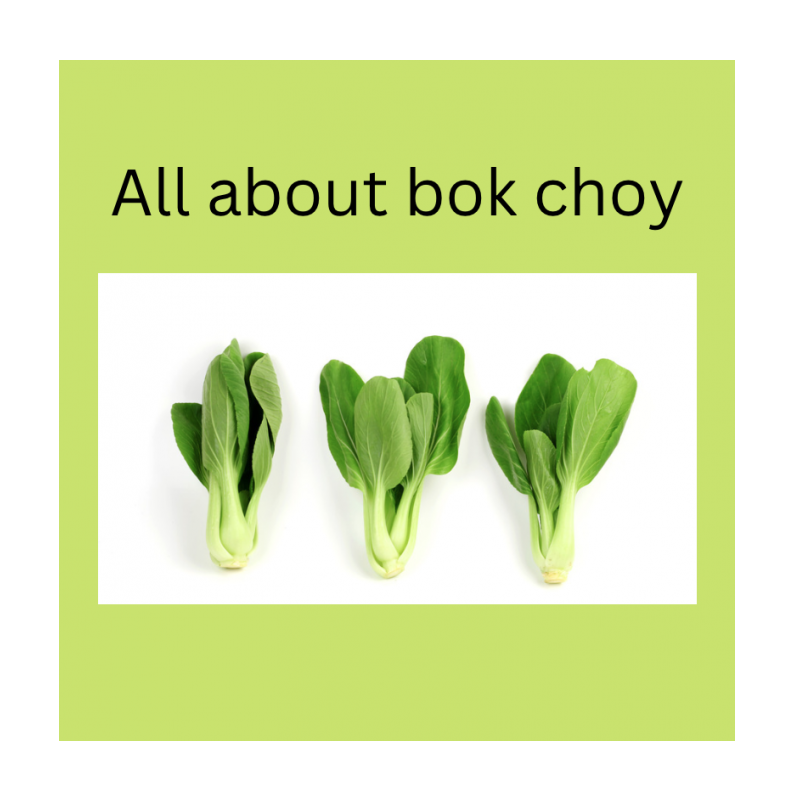BOK CHOY: THE GATEWAY GREEN

If you’re new to adding more plants to your plate, I’d recommend starting with bok choy as it’s mild in flavor, has a soft texture and can be eaten raw or slightly cooked.
Bok choy, baby bok and Shanghai baby bok have become widely available in the US, but I sometimes still rarely find people cooking with it or using it in recipes. It’s been a staple in Chinese and other Asian country home kitchens for about 1500 years and Americans have been enjoying it for about 100. Because of the incredible health benefits and its mild flavor, I’m hoping that it can gain a little more traction here at home.
Classified as a Chinese cabbage, Bok Choy is one of the many different varieties. Some of the other names you might see:
-
white cabbage
-
mustard cabbage
-
celery cabbage
-
Chinese white cabbage
-
Chinese mustard
-
white celery mustard
When specifically looking for a bok choy, you might also see names like buk, pok or pak as the first word and choi/choy are both also used. Essentially, this means white cabbage.
You may know by now that if we’re talking cabbage – that means CRUCIFEROUS! That’s right, these too, bolt the little blooms with 4 petals indicating a cross. So, they are pretty and a POWERHOUSE of dense nutrition!
THE GOOD STUFF!
Just look at that potassium! Compared to banana at 422mg per serving, bok choy offers a whopping 631mg and this is only one cup, cooked! Vitamins K, C, and A (carotenoid form) are all in high value. And calling all moms-to-be, folate is a heavy hitter too! Also, take note of that iron which is somewhat abundant, because vitamin C aids in the absorption of iron, you’ll be sure to take up most of what bok choy has to offer.
Additionally, it has a good representation of B vitamins and look at that--- protein makes a strong show!
"...phytonutrients in bok choy represent what is now known to be a full spectrum of over 70 antioxidants in this cruciferous vegetable. The antioxidant richness of bok choy partly explains ongoing investigation of bok choy in relationship to cancer prevention since prevention and reduction of oxidative stress has often been linked to decreased cancer risk. In most research studies, increased intake of antioxidant nutrients from vegetables like bok choy has been associated with decreased oxidative stress, and this connection is one way that researchers explain the ability of certain vegetables to lower cancer risk. (Too much oxidative stress can leave our cells too susceptible to damage from free radicals and too much at risk for potential transformation into pre-cancerous cells.)"
-WHFOODS.ORG
ANTI-NUTRIENTS
Now, sometimes there is some chatter about the anti-nutrients in some cruciferous vegetables. To put that to rest here for bok choy (and all its varieties), it is quite low in oxalate values. Normally, calcium and small amounts of oxalate are present in the urinary tract at the same time, but they remain dissolved and cause no problems. However, sometimes they bind to form crystals. In some people, these crystals can lead to the formation of stones, especially when oxalate is high and urine volume is low. I eat a tremendous amount of greens, both cooked and raw, and have never had a problem with stone formation. Furthermore, in all of my years of eating this way and coaching others, I have run across only one person who developed stones after jumping into a plant-based diet and upping the amount of greens in their diet. They are still plant-based, but have now varied their green intake (they were focused on only one type of green when they made the switch to plant-based). Additionally, by steaming or lightly cooking greens you can bring that oxalate level down.
There is also talk about Glucosinolates in cruciferous vegetables. Gluconsinlates are sulfur containing phytonutrients originally synthesized in plants from sugars and amino acids. While not only in cruciferous vegetables, they do tend to be concentrated there. Gluconsilates have been known to block iodine absorption causing problems for the thyroid, sometimes resulting in an iodine deficiency and presenting as a goiter. (This is is the most common cause of goiter. The body needs iodine to produce thyroid hormone. If you do not have enough iodine in your diet, the thyroid gets larger to try and capture all the iodine it can, so it can make the right amount of thyroid hormone.)
Alternatively, gluconsinlates are the a part of the precursor in the formation of sulforaphane and plays a significant role in fighting cancer. Here's some additional information on gluconsinlates and you’ll see that in the studies done (on animals), they did not experience goiters, their intake of gluconsinlates concentrated in feed was far greater than any person would consume in vegetables within a day's time.
Here’s more on Anti-nutrients from Harvard.
COOKING
Because bok choy has such a mild flavor, eating it raw makes it easy to incorporate into salads with other green varieties.
As most plants are, this one is quite delicate, especially the baby forms. Therefore, if you choose to cook it, use the dry saute method and cook quickly. The entire plant is edible, so be sure to eat the thicker and crisp ends! Simply, wash and cut them into even bite sized pieces and allow those to cook a little longer. Then, tear up the leaves and just give them some quick heat as they will wilt quickly and lose nutrition.
RECIPE
Bok Choy and Tofu in a Garlic Ginger Sauce
-
3/4 cup vegetable broth
-
6 cloves garlic, minced
-
2 tablespoons of liquid sweetener (date syrup or maple syrup is preferred)
-
1 tablespoon grated fresh ginger
-
heavy pinch of red chili pepper
-
1 tablespoon coconut aminos
-
1 tablespoon rice vinegar
-
6 heads baby bok choy, halved lengthwise
-
4-6 baby bok choy, mini, or, 2 long choy, or one regular bok choy (whatever variety you get is fine)
-
1/2 yellow onion, cut to 1/2” half moons
-
1 bell pepper, slivered
-
1/2 block of tofu, squeezed and cut to small cubes
-
sesame seeds for garnish
Add the broth, garlic, ginger, chil pepper, aminos and vinegar to a bowl and whisk well. Shaking in a jar is also a good idea. Set aside.
Cut the very end (rough end) of the bok choy off to where the whole bunch falls apart. Now you can easily rinse off any dirt at the bottom. Cut the thicker ends off and then into 1/”4 strips. Cut your onion and bell pepper.
To a hot skillet have a little bit of water or broth off to the side to do your dry saute. Add the bok choy ends, onion, bell pepper and tofu. Saute for 4-5 minutes, until the onion begins to become translucent. Add the ginger garlic mixture and cook for one more minute, just enough to warm up the liquid. Don’t over cook.
Tear/cut the leaves of the bok choy onto large pieces and add to the pan, the leaves will soon become bright green and wilt.
Transfer everything to a serving bowl over brown rice and garnish with sesame seeds. Be sure to pour any excess ginger-garlic sauce into the bowl to coat the rice. Enjoy!
--------
Do you know about our STREAMING PLUS membership?
Our membership is built like a streaming service - you get a full library of plant-based cooking classes to watch whenever you want. PLUS, you gain access to upcoming interactive virtual cooking classes and a monthly accountability group call.
As a member you get:
- Complete library of all past virtual classes - stream them whenever you’d like!
- Free access to upcoming virtual classes
- Library of easy and quick recipes: 100 and growing
- Access to private Facebook group
- Monthly accountability check-in and support group Zoom call with Caryn
- Quarterly “Ask the Doc” call with Dr. Jim Loomis, our Medical Director
- 20% off all virtual multi-week programming
- A community of support
To learn more, please visit us here.

